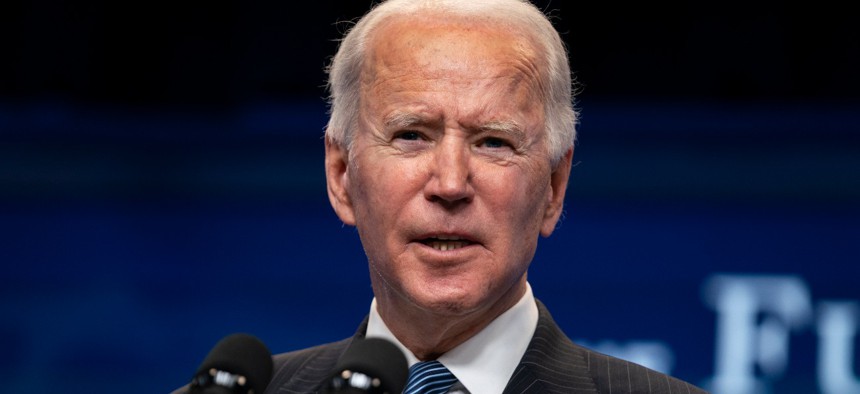The Fine Print of Biden’s Directive Rescinding Trump-Era Workforce Orders
Agencies will be required to reverse actions taken during the Trump administration to implement a slew of anti-union policies, including renegotiate collective bargaining agreements.
President Biden last week signed an executive order rescinding former President Trump’s signature federal workforce initiatives, undoing measures aimed at crippling unions and an effort to turn so-called “policy-making” federal workers into at-will employees.
The order rescinds the Schedule F job classification, which was designed to convert potentially thousands of federal workers out of the federal government’s competitive service and thereby strip them of most civil service protections. It also rolls back directives to make it easier to fire federal employees, reduce the scope of federal sector collective bargaining and severely restrict union officials’ access to official time.
“Career civil servants are the backbone of the federal workforce, providing the expertise and experience necessary for the critical functioning of the federal government,” the directive states. “It is the policy of the United States to protect, empower and rebuild the career federal workforce. It is also the policy of the United States to encourage union organizing and collective bargaining. The federal government should serve as a model employer.”
Despite the White House’s swift action to repeal the Trump administration’s workforce initiatives, the executive order marks the start of agencies’ work to restore union rights in the workplace. The order instructs agency heads to identify a series of actions taken over the last four years to roll back.
On Schedule F, agencies must “immediately suspend, revise or rescind” any actions they has taken to implement the new job classification, while the director of the Office of Personnel Management “shall immediately cease processing” agencies’ requests to reclassify workers or create new positions in Schedule F.
In unwinding Trump’s union directives, agencies are tasked with rolling back any efforts to implement restrictions on lobbying Congress while on official time, as well as removing a cap of 25% of an employee’s work hours on official time, bans on union access to free or subsidized office space and other office supplies, and bans on union officials’ ability to use official time to participate in grievance proceedings. They also must cease efforts to develop systems to monitor the use of official time, as well as policies requiring union officials to receive advanced permission in writing to use official time.
Agency heads must undo any changes to their disciplinary and unacceptable performance policies made following the enactment of Trump’s workforce orders, and the Office of Personnel Management is required to roll back regulations issued last October making changes to how agencies handle federal workers’ probationary periods and performance-based demotions and removals.
Although the order does not explicitly instruct agencies to reopen union contracts for renegotiation, it includes collective bargaining agreements among the actions that agencies should identify and rescind as part of the implementation of Biden’s directive.
Robert Tobias, distinguished practitioner in residence at American University’s Key Leadership Program and a former president of the National Treasury Employees Union, said that while the entire executive order is important in restoring balance to federal labor-management relations, one provision on which to keep an eye is the requirement that agencies “elect to negotiate” over permissive bargaining subjects, including “the numbers, types, and grades of employees or positions . . . or the technology, methods and means of performing work.”
“This has been an issue for years and years and years, since the beginning of the statute,” Tobias said. “[Former President] Clinton in his [labor-management] executive order said that agencies had the option to do that. We—NTEU—joined in a couple of lawsuits to enforce that, but the courts said that you can’t enforce a presidential directive to bargain on [these subjects], so it can’t be enforced through an unfair labor practice or a lawsuit. So it’s important that [Biden] made that statement, but what’s the follow up going to be to ensure that it’s obeyed?”
Tobias cited Biden’s video message to federal workers as a positive sign that the new president sees the federal workforce as a partner, but said the new administration’s approach to collective bargaining is not yet clear. He noted that last week’s executive order does not reinstate the agency labor-management councils established under the Clinton and Obama administrations.
“The order has implementation in that sense through the revocation [of Trump’s policies], but it doesn’t establish the means by which [the government will move forward],” Tobias said. “The roll back is very significant, but what will the new policy be on how parties ought to behave toward each other? Will that be based on the Clinton and Obama orders, and how will the new order be supported?”








